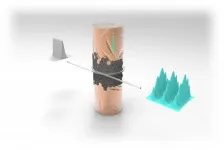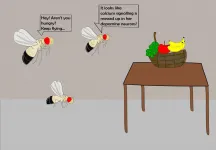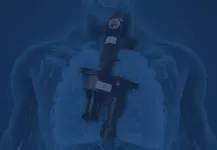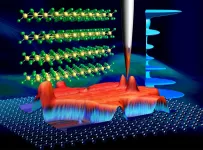(Press-News.org) New research shows that patterns inspired by lobster shells can make 3D printed concrete stronger, to support more complex and creative architectural structures.
Digital manufacturing technologies like 3D concrete printing (3DCP) have immense potential to save time, effort and material in construction.
They also promise to push the boundaries of architectural innovation, yet technical challenges remain in making 3D printed concrete strong enough for use in more free-form structures.
WATCH AND EMBED THE VIDEO: https://youtu.be/mpPAPlst42o
In a new experimental study, researchers at RMIT University looked to the natural strength of lobster shells to design special 3D printing patterns.
Their bio-mimicking spiral patterns improved the overall durability of the 3D printed concrete, as well as enabling the strength to be precisely directed for structural support where needed.
When the team combined the twisting patterns with a specialised concrete mix enhanced with steel fibres, the resulting material was stronger than traditionally-made concrete.
Lead researcher Dr Jonathan Tran said 3D printing and additive manufacturing opened up opportunities in construction for boosting both efficiency and creativity.
"3D concrete printing technology has real potential to revolutionise the construction industry, and our aim is to bring that transformation closer," said Tran, a senior lecturer in structured materials and design at RMIT.
"Our study explores how different printing patterns affect the structural integrity of 3D printed concrete, and for the first time reveals the benefits of a bio-inspired approach in 3DCP.
"We know that natural materials like lobster exoskeletons?have evolved into high-performance structures over millions of years, so by mimicking their key advantages we can follow where nature has already innovated."
3D printing for construction
The automation of concrete construction is set to transform how we build, with construction the next frontier in the automation and data-driven revolution known as industry 4.0.
A 3D concrete printer builds houses or makes structural components by depositing the material layer-by-layer, unlike the traditional approach of casting concrete in a mould.
With the latest technology, a house can be 3D printed in just 24 hours for about half the cost, while construction on the world's first 3D printed community began in 2019 in Mexico.
The emerging industry is already supporting architectural and engineering innovation, such as a 3D printed office building in Dubai, a nature-mimicking concrete bridge in Madrid and The Netherlands' sail-shaped "Europe Building".
The research team in RMIT's School of Engineering focuses on 3D printing concrete, exploring ways to enhance the finished product through different combinations of printing pattern design, material choices, modelling, design optimisation and reinforcement options.
Patterns for printing
The most conventional pattern used in 3D printing is unidirectional, where layers are laid down on top of each other in parallel lines.
The new study published in a special issue of 3D Printing and Additive Manufacturing investigated the effect of different printing patterns on the strength of steel fibre-enhanced concrete.
Previous research by the RMIT team found that including 1-2% steel fibres in the concrete mix reduces defects and porosity, increasing strength. The fibres also help the concrete harden early without deformation, enabling higher structures to be built.
The team tested the impact of printing the concrete in helicoidal patterns (inspired by the internal structure of lobster shells), cross-ply and quasi-isotropic patterns (similar to those used for laminated composite structures and layer-by-layer deposited composites) and standard unidirectional patterns.
Supporting complex structures
The results showed strength improvement from each of the patterns, compared with unidirectional printing, but Tran said the spiral patterns hold the most promise for supporting complex 3D printed concrete structures.
"As lobster shells are naturally strong and naturally curved, we know this could help us deliver stronger concrete shapes like arches and flowing or twisted structures," he said.
"This work is in early stages so we need further research to test how the concrete performs on a wider range of parameters, but our initial experimental results show we are on the right track."
Further studies will be supported through a new large-scale mobile concrete 3D printer recently acquired by RMIT - making it the first research institution in the southern hemisphere to commission a machine of this kind.
The 5×5m robotic printer will be used by the team to research the 3D printing of houses, buildings and large structural components.
The team will also use the machine to explore the potential for 3D printing with concrete made with recycled waste materials such as soft plastic aggregate.
The work is connected to a new project with industry partners Replas and SR Engineering, focusing on sound-dampening walls made from post-consumer recycled soft plastics and concrete, which was recently supported with an Australian Government Innovations Connections grant.
INFORMATION:
'Influences of printing pattern on mechanical performance of 3D printed fibre-reinforced concrete', with collaborators Luong Pham (first author and RMIT PhD researcher) and Professor Guoxing Lu (Swinburne University), is published in 3D Printing and Additive Manufacturing (DOI: 10.1089/3dp.2020.0172).
Pulsed lasers repeatedly emit light for a short period of time as if blinking. They have the advantage of focusing more energy than a continuous wave laser, whose intensity is kept unchanged over time. If digital signals are loaded in a pulsed laser, each pulse can encode one bit of data. In this respect, the higher the repetition rate, the more the amount of data that can be transmitted. However, conventional optical-fiber-based pulsed lasers have typically had a limitation in increasing the number of pulses per second above the MHz level.
The Korea Institute of Science and Technology (KIST) announced that the research ...
Synthetic cannabidiol, better known as CBD, has been shown for the first time to kill the bacteria responsible for gonorrhoea, meningitis and legionnaires disease.
The research collaboration between The University of Queensland and Botanix Pharmaceuticals Limited could lead to the first new class of antibiotics for resistant bacteria in 60 years.
The UQ Institute for Molecular Bioscience's Associate Professor Mark Blaskovich said CBD - the main nonpsychoactive component of cannabis - can penetrate and kill a wide range of bacteria including Neisseria gonorrhoeae, which causes ...
'A journey of a thousand miles begins with a single step' is a popular adage that talks about the initial thrust required to embark on a task. However, once begun, how do we persevere on the job and not let it fall apart like a New Year resolution? How do we stay motivated?
Well, these are not just philosophical deliberations, but compelling science projects for neuroscience aficionados. Scientists have in fact been on the lookout for the neuronal and molecular players which are at the root of governing motivation.
Here is a research story from the generous fruit fly that identifies the machinery behind the fly's relentless flying pursuits.
Prof. Gaiti Hasan's group, in a recent study, has discovered that the ability of flies to sustain ...
Your food intake patterns are partly under genetic control, according to the latest research from researchers at King's College London, published today in the journal Twin Research and Human Genetics.
Researchers can study the quality of an individual's typical diet by using a type of analysis called 'dietary indices'. Researchers use dietary indices to understand what foods someone eats and the nutrients provided, compared with recommended guidelines.
The team analysed food questionnaire responses from 2,590 twins, using nine commonly used dietary indices. The researchers studied the degree of similarity among identical twins - who share 100% of their genes - compared with non-identical twins, who share 50% of their genes.
The team found that identical twin pairs ...
The design, testing, and validation of the Illinois RapidVent emergency ventilator has been published in the journal Plos One. The article, "Emergency Ventilator for COVID-19," by University of Illinois Urbana researchers, is the first of its kind to report such details about an emergency ventilator that was designed, prototyped, and tested at the start of the COVID-19 pandemic in 2020.
"This article reports the development and testing of the RapidVent emergency ventilator," said William King, professor at The Grainger College of Engineering and Carle Illinois College of Medicine, and leader of the RapidVent ...
Previously controversial values of the energy gap of a van der Waals material -- chromium tribromide -- were reported based on various optical measurements. A University of Wyoming faculty member and his research team used scanning tunneling microscopy and spectroscopy measurements that clearly reveal a much smaller energy gap value and resolved the controversy.
"Our results settled a long controversy on one important material property -- the energy gap of the material," says TeYu Chien, an associate professor in the UW Department of Physics and Astronomy. "Our scanning tunneling microscopy and spectroscopy measurements clearly revealed that the energy gap is around 0.3 electron volt (eV), which is much smaller than those measured by optical ...
Nearly every galaxy hosts a monster at its center -- a supermassive black hole millions to billions times the size of the Sun. While there's still much to learn about these objects, many scientists believe they are crucial to the formation and structure of galaxies. What's more, some of these black holes are particularly active, whipping up stars, dust and gas into glowing accretion disks emitting powerful radiation into the cosmos as they consume matter around them. These quasars are some of the most distant objects that astronomers can see, and there is now a new record for the farthest one ever observed.
A team of scientists, led by former UC Santa Barbara ...
What's the relationship between money and well-being? "It's one of the most studied questions in my field," says Matthew Killingsworth, a senior fellow at Penn's Wharton School who studies human happiness. "I'm very curious about it. Other scientists are curious about it. Laypeople are curious about it. It's something everyone is navigating all the time."
To answer this question, Killingsworth collected 1.7 million data points from more than 33,000 participants who provided in-the-moment snapshots of their feelings during daily life. In a paper in the Proceedings of the National Academy of Sciences, Killingsworth confirms that money does influence happiness and, contrary to previous influential research on the subject suggesting that this plateaus above ...
'What goes in, must come out' is a familiar refrain. It is especially pertinent to the challenges facing UBC researchers who are investigating methods to remove chemicals and pharmaceuticals from public water systems.
Cleaning products, organic dyes and pharmaceuticals are finding their ways into water bodies with wide-ranging negative implications to health and the environment, explains Dr. Mohammad Arjmand, an assistant professor of mechanical engineering at UBC Okanagan.
And while pharmaceuticals like a chemotherapy drug called methotrexate can be highly effective ...
The team led by Professor Rolf Heumann, Senior Researcher for Molecular Neurobiochemistry at RUB, is hoping that this will allow the effects of neurodegenerative diseases such as Parkinson's to be alleviated over the long term. The results of the work were published on 31 December 2020 in the journal Scientific Reports.
Neurites do not know the way
Restoring brain function following an injury or due to neurodegenerative diseases remains an unresolved problem in neuroscience and medicine. Regeneration in the central nervous system is only possible to a very limited ...





